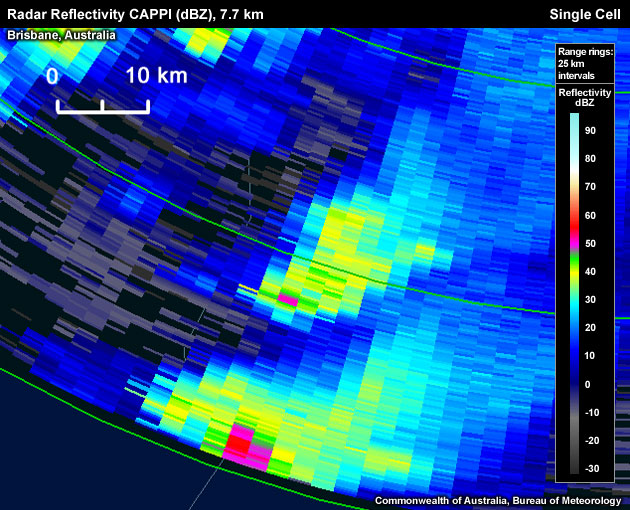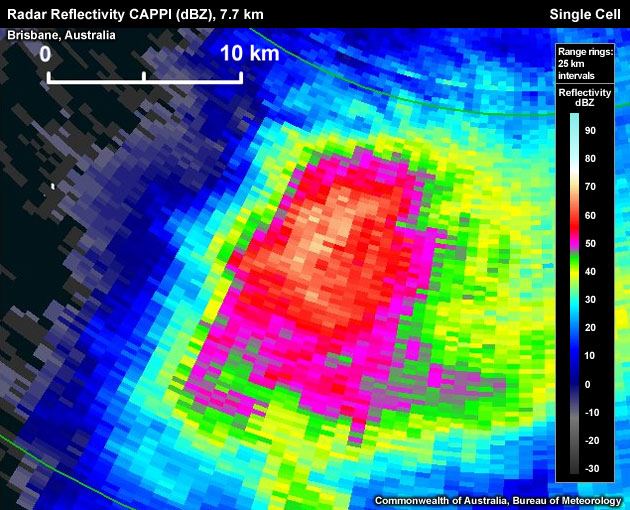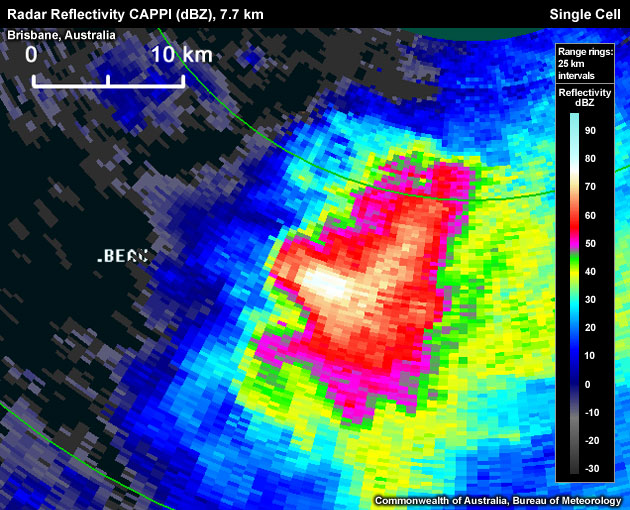Diagnosis
Once you have confidently identified a Single Cell signature, this section will help you estimate the storm severity associated with it. Generally, the spatial and temporal scales of a signature are loosely related to the updraft strength. In other words, the larger and/or more long–lived the signature, the stronger the updraft that produced it. In velocity-based signatures, updraft severity can usually also be gauged by the magnitude of the measured radial velocities. Examining a storm’s overall temporal evolution will suggest whether the storm is becoming more or less severe. Radar signatures and associated storm developments can also be time-shifted relative to each other, as is the case in supercell tornadoes that occur during the collapse of the parent storm.
When comparing signatures to diagnose relative severity, keep in mind that it is assumed that signatures are sampled at equal ranges from the radar. Otherwise, a storm sampled at greater range (with a wider beam) can appear to be weak and/or weakening, while a storm sampled at a closer range (with a narrower beam) can appear to be strong and/or strengthening.
Degree of Severity
As the Single Cell signature in moderate to strong deep layer shear is a representation of an organised multicell or supercell thunderstorm, there are certain characteristics that can be investigated to help diagnose the likelihood of the severity of the thunderstorm.
- Horizontal size of the single cell signature, as measured through the extent of the 50 dBZ echo top.
The larger the area of >50 dBZ echoes in a CAPPI level set according to the nomogram, the greater the volume of hail within the ideal hail growth layer, which in turn is a proxy for updraft mass flux

Only a couple pixels exceed 50 dBZ within the CAPPI level.

A large area of > 50 dBZ pixels within the CAPPI level.
- Maximum dBZ – The larger the maximum dBZ value in the 2 cm hail CAPPI plane, the more confidence the user can have that the echoes represent large hail.

Maximum reflectivity is approximately 50 dBZ.

Maximum reflectivity is approximately 80 dBZ.
- Longevity – > 50 dBZ pixels "breaking through the CAPPI" level for longer amounts of time should increase confidence that the underlying updraft is "stabilised" by the interaction with deep layer shear.
Loop of >50 dBZ echo "breaking through the CAPPI". Note the storm in the steady western storm persisting, whereas the eastern storm is much less steady.
- Anamalous Storm Propagation – The more anomalous the movement of the "single cell" in comparison to the deep layer background flow and/or the motion vectors of other thunderstorms in the region, the more likely it is that this thunderstorm has or can obtain supercell attributes, given moderate or higher deep layer shear.
This loop shows the gradual emergence of two dominant, single cell echo tops in a splitting supercell case. The system starts off with a tightly grouped multicell cluster possessing a common anvil. Then, two single cell signatures begin to emerge in both the left and right moving storms. In particular, the left-mover retains its multicellular character, even after the splitting process.
Considering all these aspects of the Single Cell signature will help to determine overall whether you are dealing with a significant signature. However, radar information should never be used in isolation and should always be used in conjunction with the near storm environment and any reports.
Most Likely Convective Hazards
If a thunderstorm featuring a single cell signature in a moderate to strong deep layer shear environment has been determined to be severe, all of the following convective hazards should be considered to be included in the severe thunderstorm warning:
- Damaging winds – due to the indication the thunderstorm is an organised multicell or supercellular. Both storm types possess strong updrafts, therefore strong downdrafts are possible
- Large hail – a longer–lived high reflectivity single cell echo indicates prolonged residence times of larger hydrometeors in cold thermal layers (–10 °C to –30 °C) conducive to hail growth
- Heavy rainfall resulting in flash flooding – steadier storms in a moderate deep layer shear environment can deliver more continuous and/or intense precipitation. Flash flooding is particularly a consideration if such storms move slowly or several such storms train across the same location.
- Tornadoes – in stronger deep layer and strong low–level shear, single cell signatures indicating a supercell indirectly harbour the risk of supercell tornadoes. However, based on Duda and Gallus (2010) only 28% of supercells are tornadic. These odds increase in storm environments with strong 0-1 km shear and low Lifted Condensation Levels (LCLs).
See Conceptual Models for more details on why particular severe weather should be included.
